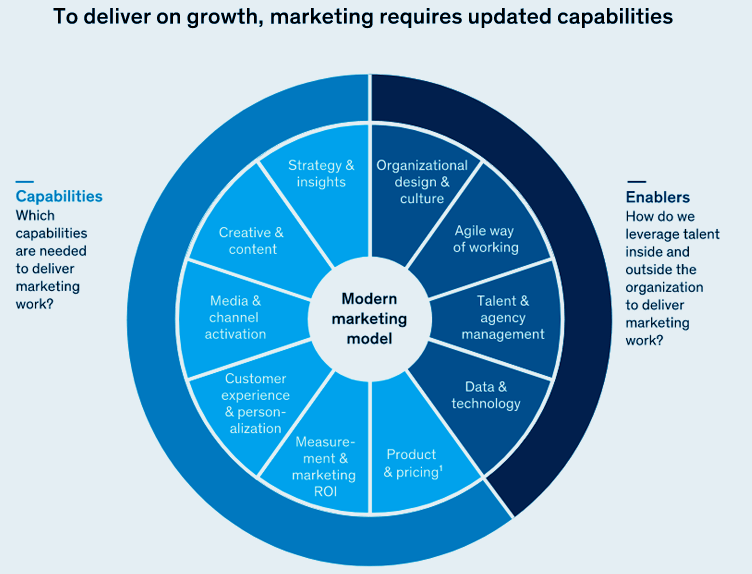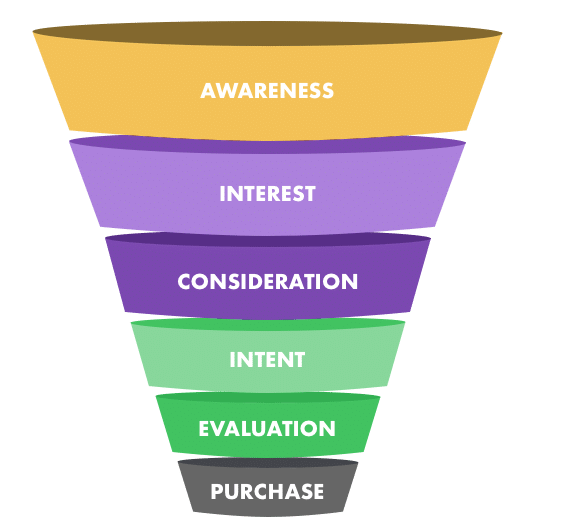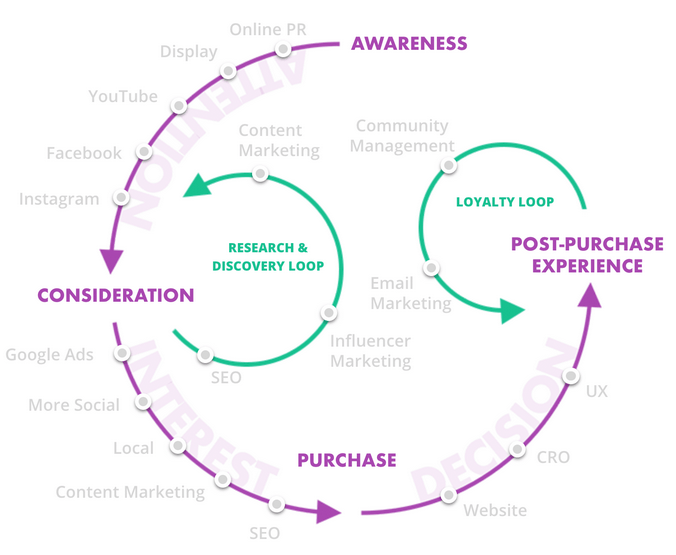While the idea of full-funnel marketing in Insurance Industry has been around for years, most insurance companies have been unable to overcome the organizational and technological barriers to actually implementing it effectively.
There are several reasons why now is a critical time for marketers to lean into full-funnel marketing. A full-funnel strategy can help you reach more shoppers across more touch points
For one, performance-marketing returns have recently plateaued or declined, thanks to inflation in digital-media costs and customer saturation in some highly targeted ad markets.
Widely available automation tools have commoditized the execution of performance insurance marketing, making it difficult to secure a significant competitive advantage.
Driving full-funnel marketing in insurance is particularly necessary given the dramatic changes in customer behavior seen during the COVID-19 pandemic.
What is full-funnel marketing?

When we say “funnel,” we’re referring to the marketing funnel, which outlines the most straightforward journey your customer might take in the path to purchase. The top of the marketing funnel represents shoppers in the awareness stage, and the bottom of the funnel represents shoppers in the purchasing stage.
Upper-funnel marketing refers to strategies to build brand awareness. For example, many TV commercials are designed to build awareness among audiences who may not have a need for the product yet.
Mid-funnel marketing strategies typically focus on building consideration and standing out in your category. For example, blog content can help differentiate a product from others in its category.
Lower-funnel marketing drives purchase among shoppers who show potential to buy. For example, remarketing ads with calls-to-action like “Buy now” can bring shoppers closer to the point of purchase.
A full-funnel marketing strategy builds awareness, consideration, and purchase simultaneously.
The marketing funnel is a helpful framework for engaging audiences. At the same time, customer journeys and funnels aren’t interchangeable concepts. Funnels are linear, but customer journeys rarely move directly from awareness to consideration to purchase.

Leading insurance organizations are moving toward “full-funnel” marketing, an approach that combines the power of both brand building and performance marketing through linked teams, measurement systems, and key performance indicators (KPIs).
This year, more than 60% of consumers tried a new shopping behavior in response to economic pressures, store closings, or changing priorities, one-third of whom experimented with a different brand of product.
This wave of data on new behaviors has provided marketers with a windfall in terms of developing a better understanding of what their customers want and how they make decisions across the entire funnel, offering an opportunity to both win new customers and ensure the loyalty of existing ones.
Delivering on this promise requires a whole new way of operating. Marketing departments need to be rewired for speed, collaboration, and customer focus. It’s less about changing what marketing does and more about transforming how the work is done.
Based on successful cases we’ve seen, we estimate that making this change can unlock 5 to 15% of additional growth and trim 10 to 30 percent of marketing costs.
In our experience, most senior leaders understand that marketing has to modernize, but they are less sure what specifically that means. Too often, they focus on a handful of initiatives or capabilities and then grow frustrated when the promised value doesn’t appear.
For this reason, it’s crucial to have a clear view of what constitutes a model for modern marketing. While each of these components is familiar, we have found that the clarity of seeing them organized into a cohesive model gives leaders a better sense of how to track all the elements and how they should work together.

The traditional way to create content, for instance, is to roll out periodic, one-size-fits-all campaigns that can be modified only to a limited extent. On the other hand, a modern marketing organization has systems that allow for large volumes of messages and content to be constantly created, monitored by performance analytics, and then adjusted as needed.
Take personalization. It used to mean broad offerings and experiences across large consumer segments. Today, the goal is to leverage data from all consumer interactions to creatively deliver as much relevant one-to-one marketing as possible.
Consumer behavior has changed, and by extension so has the journey that consumers follow. It is only logical, then, to ditch the old model in favor of something that accurately describes the digital buyer’s journey of today.
In general,the digital marketing funnel serves as a framework to help understand and follow the various stages consumers pass through during the customer lifecycle.
Main Stages of the Insurance Digital Marketing Funnel

But the new digital marketing funnel is a looping journey with twists and turns.

The brands that do better are the ones who implement a full-funnel marketing strategy.
88% of online shopping orders worldwide did not convert into a purchase. One of the reasons for this is that many marketers still focus on a sales-heavy marketing strategy, which is all about pushing people to buy.
A full-funnel marketing strategy involves tailoring your marketing messages to the particular stage of purchase a customer is currently at. Rather than focusing only on sales, it considers the entire 360-degree customer journey and attempts to nurture relationships and build better brand experiences.
A good full-funnel strategy is heavily informed by data. This data, which is collected from a range of internal and external sources, enables you to tailor and optimize your efforts at each stage of the journey. The results are more sales and a greater ROI.
Essentials of Full-funnel Marketing

The contours of a full-funnel marketing program will be different for different marketers across the spectrum.
But whether CMOs are launching a new product or brand, repositioning a legacy brand, or simply trying to drive in-quarter sales, they will want to embrace four common and essential elements:
- Brand-building measurement
- A unified set of KPIs
- An updated media mix model for integrated spending
- A full-funnel operating model
By adopting full-funnel marketing, companies can become more relevant to their customers, develop a fuller and more accurate picture of marketing’s overall effectiveness, and generate more value without having to spend additional marketing dollars.
Brand-building measurement
Traditional TV ads, the backbone of many brand-building campaigns, have long suffered from a tracking problem. They offer the potential to reach large numbers of consumers and elicit powerful emotional responses, but their inflexibility prevents marketers from collecting detailed insights on how exactly the campaigns are impacting consumer behavior (see New Era of Insurance Claims Management and Customers Experience).
This is starting to change. Consumers are increasingly moving toward internet TV and digital streaming services, including audio.
These options allow marketers far greater visibility into who is seeing their ads and allows them to show different ads to different households that are watching or listening to the same program. This trend has accelerated during the pandemic.
Some 33% of consumers in Europe and 41% in the United States say they have begun or increased their usage of online streaming channels this year.
In addition, many new measurement approaches to brand campaigns have taken off in recent years, allowing marketers to move beyond such coarse methodologies as brand trackers and reach/frequency metrics:
- Addressable TV and audio. Even for linear TV viewing, set-top boxes and smart TVs can now provide visibility into who has viewed particular ads, via content-recognition technology that works with unique IP addresses. This enables advertisers to establish a much more direct link between ad exposure and consumer actions.
- Digital ‘brand lift’ surveys. Unlike traditional brand trackers, these surveys, often on mobile devices, allow marketers to measure upper-funnel metrics, such as brand awareness and favorability, on a near-real-time basis and tie them to specific ad exposure at scale. They can also isolate the impact of ads by separating recently exposed populations from unexposed groups.
- Attribution tools. Using ad logs, these tools correlate the specific time and location in which a cohort of consumers sees an ad with the actions those consumers take. For instance, in the minutes after a TV spot airs in a particular geography or is seen by a particular demographic, do search queries, website visits, or social-media mentions increase? Unlike qualitative surveys, these “correlated outcomes” don’t suffer from discrepancies between consumers’ stated and actual behavior.

A unified set of KPIs
Linking KPIs between channels and stages of the funnel to actual business results, such as conversions or leads, allows companies to better understand the real impact of their marketing and then create messages that will elicit the best responses. For instance, if unaided brand awareness is increasing, what effect, if any, is that having on website traffic or digital purchases? Are brand-building efforts leading more consumers to make branded search queries, which have a lower cost per click than generic product-category searches?
This unified view also helps marketers figure out how different touchpoints throughout the funnel affect each other and to identify the metrics that matter most.
If brand-building campaigns, for example, are leading to more website conversions or branded search queries, these are clear signs that investing in more brand building will likely pay off.
Only when marketers have linked KPIs can they identify the interactions most tightly tied to business value and start making smart decisions to adjust or rebalance their marketing spend.
An updated media mix model for integrated spending
Many marketers now rely on media mix models (MMM) to measure the impact of their campaigns and determine how much money they should spend on different types of advertising and marketing. While MMMs have proven useful for making allocation decisions, they fall short in a number of ways.
Because they require long look-back periods to estimate the impact of each type of spend, they aren’t responsive to short-term changes, such as shifts in campaign performance, or changes in shopping behavior due to external factors, such as those we are seeing today. They also don’t get very granular in their spending recommendations and can fail to capture the nuances of actual channel behavior.
A model may recommend spending increases for paid search ads on branded search terms even though a brand is already showing up in close to 100% of results.
MMMs also don’t offer granular data on which channels or platforms should get credit for customer conversions. Some 30% of marketers admit to being held back by these difficulties, including those with budgets of more than $500 million.
To make MMMs more reliable and better suited to a full-funnel marketing strategy, organizations need to modernize them with additional inputs, such as those from incrementality tests and multitouch attribution (MTA) models. Doing regular incrementality tests, which involve running a structured experiment with a control group of consumers who aren’t shown ads, can provide a cleaner verification of a particular channel’s performance, as well as insights that are closer to real-time and more granular data on campaigns.
This helps marketers assess the true impact of their efforts and adjust the attribution for a channel accordingly.
Recent technology and analytics advances have made such incrementality tests simple and inexpensive, although they are time consuming to run at scale across channels.
Advances in analytics have also helped improve the process of determining where credit for a customer conversion should go in MTA models (see Technology Strategies for Insurance Companies). Combining this with audience-propensity scoring helps further define how valuable a particular channel or tactic is. If a campaign on a particular social-media platform, for instance, converts consumers who already have a high propensity to purchase, that channel would be assigned a lower “incrementality multiplier.”
A full-funnel operating model
Full-funnel marketing requires a complete top-to-bottom integration of the function; it can’t simply be tacked onto existing daily processes. That starts with rethinking how work gets done across functions.
While the insurance transformation of an operating model requires changes across almost all elements of the marketing function, four areas are the most important to get right:
- Incentives for full-funnel performance. To help make measurement rigor a core part of marketing’s culture, marketers should be held accountable and rewarded for their ability to deliver on well-defined engagement or revenue goals. These should be based on both a unified set of KPIs tied to full-funnel performance, such as total brand awareness and total visitor traffic, and KPIs that measure incremental value, such as extra traffic coming from A/B testing or additional revenue driven by brand campaigns according to the MMM.
- Cross-functional collaboration. Full-funnel marketing can’t be done effectively without close collaboration among all stakeholders, including brand managers, performance-marketing leaders, analytics marketers, and finance. To ensure productive interaction, some companies have created weekly huddles, where insights are shared from across the funnel and decisions are made jointly on everything, including KPIs, spending levels, and which audiences to target.
- Deeper collaboration between media agency and partner. Marketers often have an incomplete understanding of what their agencies actually do and what value they are accountable for. Correcting this involves not just more active agency management but also closer collaboration. This includes ensuring that the marketers, not the agency, own their user-level data, insisting on collaboration for rapid testing and iteration, and pushing media companies to create integrated ad buys that leverage their brand-building and performance-marketing channels.
- Adoption of test-and-learn capabilities by brand marketers. The dynamic, rapid test-and-learn capabilities common to performance-marketing teams need to be extended to mid- and upper-funnel teams. Brand marketers can use these methodologies to rapidly test personalized creative and to optimize the videos or other consumer content ads that are delivered alongside, a tactic shown to be highly effective.
Full-funnel marketing is not just a campaign strategy; it’s a total shift in how marketing works. It demands close team collaboration to harness the complete range of marketing capabilities to increase the impact from all campaigns. Most importantly, it allows the CMO to provide the C-suite with a much richer and more complete picture of how exactly marketing is driving growth.
While most CMOs we know have made progress toward developing modern marketing organizations, many are discouraged by a lack of progress.
We have found that the core issues are the absence of a commitment to the full suite of changes necessary and a lack of clarity about dependencies. Without that understanding, we find that teams tend to naturally gravitate to working on things they know best or are most excited about, ignoring other elements. This creates blind spots in the transformation process that lead to delays, frustration, and, ultimately, a loss of value. Modernizing marketing capabilities, for example, requires an upgrade of four key operational enablers. But a successful transformation won’t succeed without three mindset shifts that provide a foundation for change.
……………………
AUTHORS: Jacob Ader – consultant in McKinsey’s San Francisco office, Kelsey Robinson – partner; Julien Boudet – senior partner in McKinsey’s Southern California office, Marc Brodherson – partner in McKinsey’s New York office.








